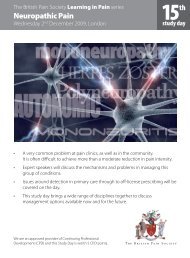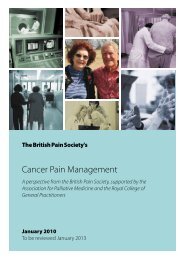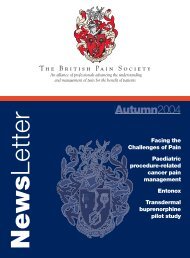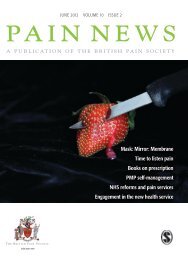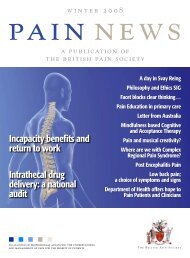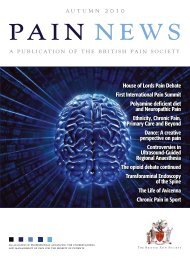Summer 2010 - The British Pain Society
Summer 2010 - The British Pain Society
Summer 2010 - The British Pain Society
You also want an ePaper? Increase the reach of your titles
YUMPU automatically turns print PDFs into web optimized ePapers that Google loves.
to carry out any treatment that<br />
a patient says he or she wants.<br />
Doctors sometimes refuse to<br />
prescribe antibiotics either because<br />
the patient doesn't need them<br />
or because over-prescription<br />
could lead to antibiotic resistance<br />
and put others at risk. Surgeons<br />
sometimes have to refuse to<br />
perform operations that patients<br />
say they want but which are<br />
considered futile or dangerous.<br />
Similarly, patients cannot require<br />
their doctors to kill them or to<br />
help them kill themselves.<br />
This bill has been designed around<br />
the wishes of a small minority<br />
of strong-minded and highlydetermined<br />
people, but it would<br />
put much larger numbers of less<br />
resolute people at serious risk of<br />
self-harm. It is not uncommon<br />
for seriously ill people to think<br />
in terms of 'ending it all' either<br />
because of transient depression<br />
or because they want to spare<br />
their families a care burden - or,<br />
in some cases, as a result of subtle<br />
coercion by others. <strong>The</strong> law as it<br />
stands protects them by putting<br />
assisted suicide or euthanasia<br />
safely out of reach. Responsible<br />
law-making has to consider the<br />
interests of the community as a<br />
whole, and especially of its most<br />
vulnerable members.<br />
Laws can and do affect social<br />
thinking. <strong>The</strong>y provide a<br />
benchmark of right and wrong,<br />
indicating to many that 'if its<br />
legal it must be ok'. This Bill runs<br />
counter to suicide preventions<br />
strategies. <strong>The</strong> Scottish Parliament<br />
would be well advised to ignore<br />
the spin and the soft euphemistic<br />
wording and to read carefully what<br />
Ms MacDonald's bill actually says<br />
and to think about what it really<br />
means.<br />
PROFESSIONAL PERSPECTIVES<br />
Diamorphine Necessary or Not?<br />
<strong>The</strong> Home Offices recent Oxycodone consultation paper stated:<br />
“<strong>The</strong> UK is a world leader in palliative care. It is one of the few countries in the world to use diamorphine, a<br />
powerful opioid analgesic which has proved to have certain advantages over other painkillers. Diamorphine has a<br />
more favourable side effect profile than morphine, in that it may cause less nausea and hypotension. Diamorphine<br />
is also more soluble than morphine which means that effective doses can be administered in smaller volumes. This<br />
is important in palliative care where patients may be emaciated.”<br />
“It has a vital place in current clinical practice in the UK. <strong>The</strong> Government considers it essential that a suitable<br />
supply of diamorphine is maintained.”<br />
<strong>The</strong>re has been an ongoing debate about the need to maintain diamorphine in the UK. This has been in part due<br />
to the episodic shortages of the drug due to its reliance on one UK manufacturer. Here 2 BPS council members –<br />
Dr Michael Platt and Professor Sam Ahmedazi put forward contrasting views on the evidence base for the need for<br />
the continued supply of diamorphine in the UK.<br />
Why diamorphine<br />
should be retained<br />
for pain management<br />
Dr Michael Platt<br />
Imperial College Healthcare NHS<br />
Trust<br />
Diamorphine was first synthesised<br />
some 136 years ago in 1874<br />
by Charles R. Alder-Wright at<br />
St Mary’s Hospital Medical<br />
School, following which it was<br />
re-synthesised and manufactured<br />
by Bayer, being released in the<br />
same year as Aspirin some 23<br />
years later 1 . Its brand name was<br />
‘heroin’, meaning ‘strong’. It<br />
has been used for the chronic<br />
cough of tuberculosis, for pain<br />
relief, breathlessness, cardiac<br />
ischaemic pain and more recently,<br />
intra-nasally for painful procedures<br />
in Accident and Emergency 2 .<br />
It is favoured by intravenous<br />
drug mis-users because of its<br />
potent and immediate ‘high’ or<br />
‘rush’, producing a potent state<br />
of euphoria. This phenomenon<br />
highlights its main advantage over<br />
morphine and other opioids, with<br />
its greater lipid solubility, 200<br />
times that of morphine 3 , due to<br />
its two acetyl moieties, enabling<br />
higher cell membrane transfer and<br />
rapid tissue penetration.<br />
It is used for pain management<br />
either systemically, via<br />
subcutaneous or intravenous<br />
routes, or spinally, via the epidural<br />
or intrathecal routes. In order to<br />
reach the mu receptors, in the<br />
dorsal horn of the spinal cord,<br />
opioids have to penetrate the dura<br />
and arachnoid layers and enter<br />
the cerebrospinal fluid, before<br />
penetrating the dorsal horn and<br />
binding to mu receptors (with<br />
lesser effects on delta and kappa<br />
receptors), producing analgesia<br />
via a G-protein coupling. When<br />
administered intrathecally these<br />
barriers are bypassed. Most<br />
epidurally administered opioids<br />
rapidly cross the dura, but the<br />
rate of penetration across the<br />
arachnoid mater is determined<br />
by lipid solubility. Drugs with low<br />
lipophilicity (e.g. morphine) cross<br />
the arachnoid slowly and have<br />
a slower onset of action; they<br />
are cleared slowly, resulting in a<br />
longer duration. Cephalad spread<br />
of drugs with low lipophilicity<br />
may result in delayed onset of<br />
nausea and respiratory depression.<br />
Drugs with higher lipid solubilities<br />
(e.g. fentanyl) have a faster<br />
onset, a shorter duration and are<br />
associated with fewer late-onset<br />
side-effects, but show more<br />
localised segmental action at area<br />
of spinal cord they are applied to,<br />
with less spread and penetration<br />
than diamorphine.<br />
PAI N N E W S S U M M E R <strong>2010</strong> 41






